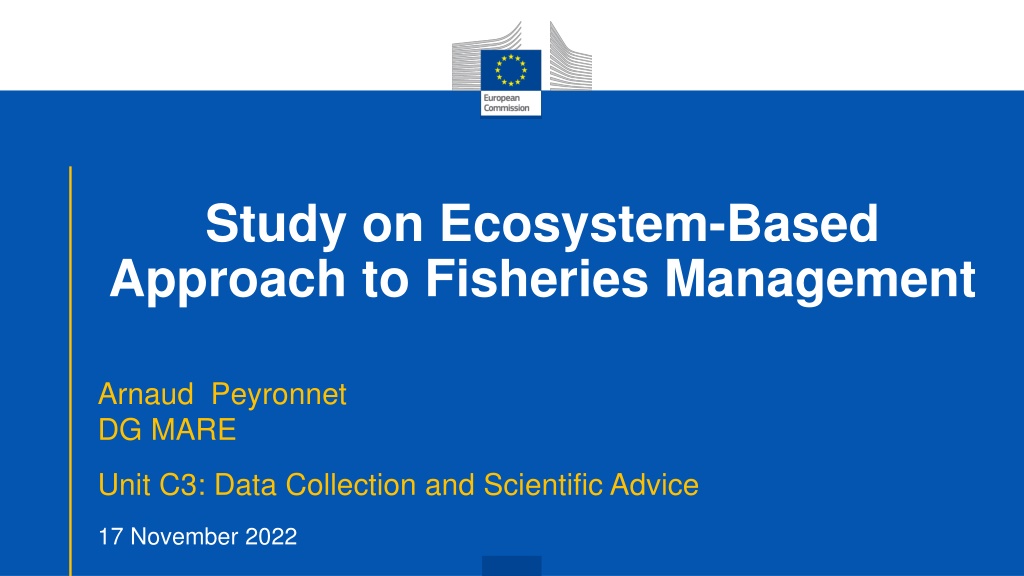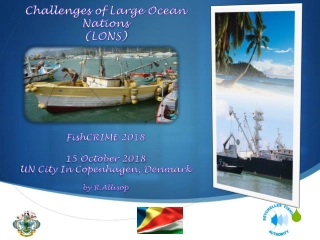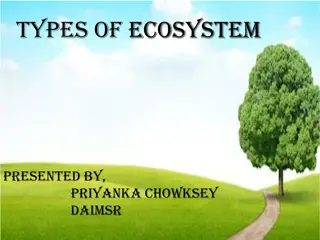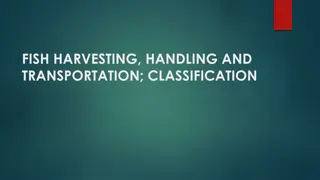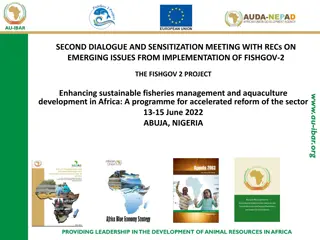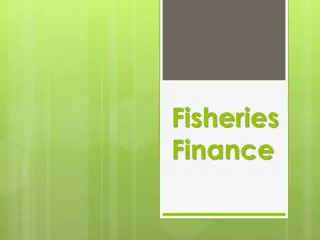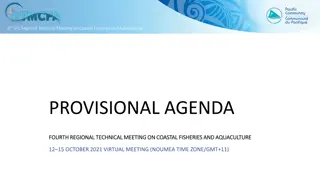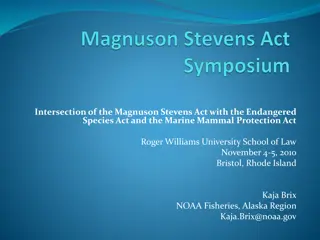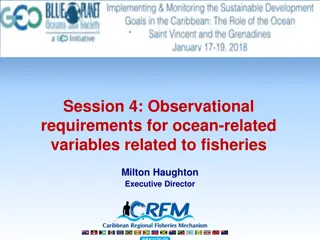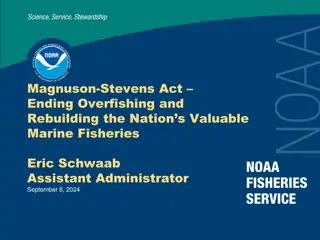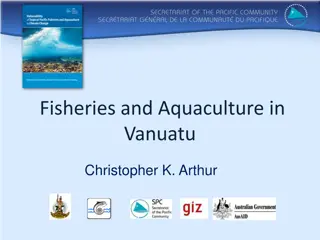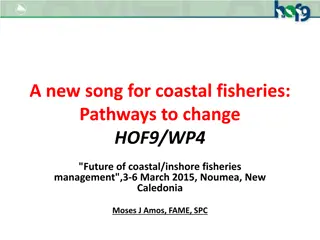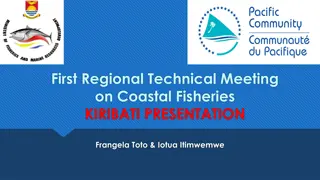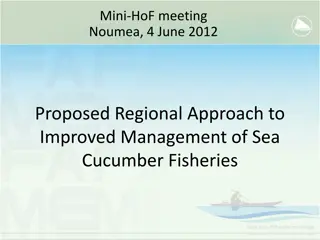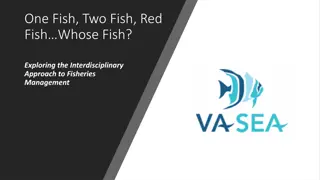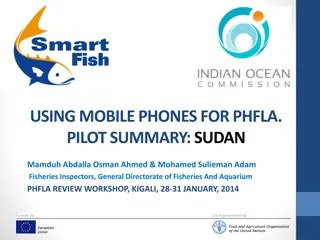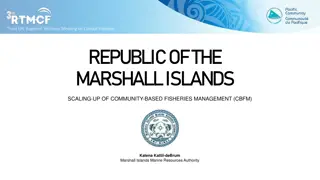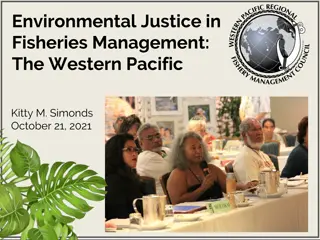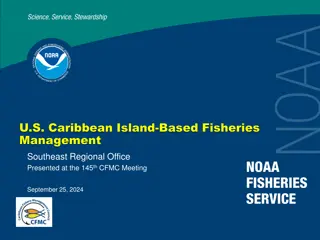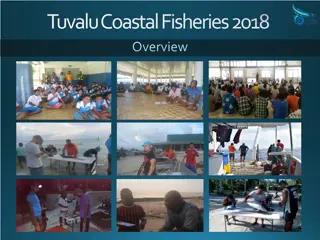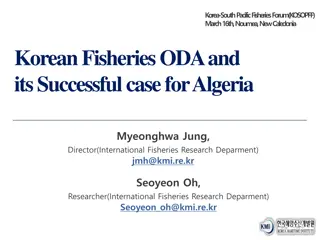Ecosystem-Based Approach to Fisheries Management Study Overview
The study focuses on assessing the current state of implementing Ecosystem-Based Approach to Fisheries Management (EAFM) within the EU, providing recommendations to address challenges and advance towards the objectives of the Common Fisheries Policy (CFP). It outlines a systematic evaluation of existing EAFM approaches, aiming to transition from single species management to a more holistic ecosystem approach. The methodology includes defining policy objectives, developing knowledge bases, and assessing alternative scenarios to provide scientific advice for effective fisheries management.
Download Presentation

Please find below an Image/Link to download the presentation.
The content on the website is provided AS IS for your information and personal use only. It may not be sold, licensed, or shared on other websites without obtaining consent from the author. Download presentation by click this link. If you encounter any issues during the download, it is possible that the publisher has removed the file from their server.
E N D
Presentation Transcript
Study on Ecosystem-Based Approach to Fisheries Management Arnaud Peyronnet DG MARE Unit C3: Data Collection and Scientific Advice 17 November 2022
EAFM in the CFP The Ecosystem-based Approach to Fisheries Management (EAFM) forms an integral part of the CFP and its objectives since 2002 Regulation (EC) 1380/2013, Article 2.3 Many ongoing actions but lack mapping of ecosystem-based approaches already in place (what has been achieved?) Need for more systematic evaluation, to identify gaps and allow progress towards the implementation of EAFM in the EU. 2
FRAMEWORK CONTRACT: STUDY ON ECOSYSTEM-BASED APPROACHES APPLIED TO FISHERIES MANAGEMENT UNDER THE CFP BALTIC SEA, NORTH SEA, ATLANTIC EU WESTERN WATERS, EU OUTERMOST REGIONS
Objectives Assess the current state of implementation of EAFM with focus on measures and the governance required, in terms of their operational readiness (Not an assesment of performance of EAFM, but instead assessment of the progress made from single species management towards and EAFM (continuum)). Provide recommendations to advance the implementation of EAFM aimed at addressing the identified challenges in order to acheive the objectives of the CFP and other policies 4
Methods 5 steps EAFM cycle 1 - Defining the frame for EAFM, starting with its aim to achieve specific policy objectives or societal goals within the social and environmental context and including the legal setting. Study tried to identify a number of EAFM challenges that, if addressed, may contribute to achieving these objectives and societal goals. Note that these objectives and societal goals are often understood to refer to the state of the ecosystem and fishing opportunities but may also involve social or economic objectives/goals. 5
Methods 5 steps EAFM cycle 1 - Defining the frame for EAFM 2 - Developing the knowledge base (which may include scientific as well as local indigenous knowledge) driven by the policy objectives or societal goals to be achieved, the relevant fisheries and potential EAFM measures. Study aimed to identify the challenges that require an understanding of the interaction of specific fisheries with the ecosystem and how this may be mitigated through specific measures. 6
Methods 5 steps EAFM cycle 1 - Defining the frame for EAFM 2 - Developing the knowledge base 3 - Assessing and weighing the EAFM alternative scenarios using the knowledge base and appropriate tools. This results in scientific advice that identifies preferred management and policy approaches. 7
Methods 5 steps EAFM cycle 1 - Defining the frame for EAFM 2 - Developing the knowledge base 3 - Assessing and weighing the EAFM alternative scenarios 4 - Implementing a specific management plan based on informed decision-making guided by best practices. This plan is an internally consistent combination of different management measures and policy instruments aimed at achieving a selection of policy objectives for a specific ecosystem and its socio-economic/institutional context 8
Methods 5 steps EAFM cycle 1 - Defining the frame for EAFM 2 - Developing the knowledge base 3 - Assessing and weighing the EAFM alternative scenarios 4 - Implementing a specific management plan 5 - Following-up with an assessment of the state of affairs pertaining to the implementation of EAFM. This includes both the EAFM process, including the preceding steps, as well as its performance in achieving the specific policy objectives or societal goals. These five stages represent one EAFM cycle where the follow-up step provides the basis for the advancements in the next EAFM cycle (adaptive process). 9
Methods Literature review to identify a hierarchical typology of EAFM challenges that distinguished three main types of EAFM challenges: 1 - Challenges to mitigate fishing impacts 2 - Challenges to improve the advisory process and its knowledge base 3 - Challenges to improve the decision-making process. 10
Methods 3 EAFM challenges Improve knowledge base and advisory process Mitigate fisheries impacts Improve decision- making process Catch & Bycatch commercial species Bycatch Non-target species Habitat disturbance Indirect effects through foodweb
Methods 3 EAFM challenges Improve knowledge base and advisory process Mitigate fisheries impacts Improve decision- making process Catch & Bycatch commercial species Change in the ecological context (other pressures or environment) Bycatch Non-target species Habitat disturbance Indirect effects through foodweb Inherent natural variability
Methods 3 EAFM challenges Improve knowledge base and advisory process Mitigate fisheries impacts Improve decision- making process Catch & Bycatch commercial species Socio-economic context on fisheries and management Change in the ecological context (other pressures or environment) Bycatch Non-target species Habitat disturbance Governance EAFM process: Trade-offs policy goals Indirect effects through foodweb Inherent natural variability
Methods Fisheries and Management Measures To assess the current state of implementation of an EAFM, key EAFM components were identified (i.e. the fisheries - both commercial and recreational- and the management measures and their legal settings). Fisheries: a group of vessel voyages targeting the same (assemblage of) species and/or stocks, using similar gear, during the same period of the year and within the same area (ICES, 2003). These fisheries were expected to have sufficiently similar impact on the ecosystem, and could be used as the basic unit for the assessment. Analysis of landings and species composition by the m tiers identified 227 fisheries relevant for EAFM (156 in European waters, excluding Mediterranean and Black Seas, and 71 in the Outermost Regions, and including recreational fisheries).
Methods A review of existing management measures identified three broad types of measures: Fisheries and Management Measures 1. Input measures, including Technical Conservation Measures (TCM) consisting of gear-based TCM (e.g. mesh size changes or sorting grids) and spatial/temporal TCM (e.g. no-take zones or real-time closures) and capacity and effort controls. 2. Output measures, including Total Allowable Catch (TAC), landing size and discard bans. 3. Ecosystem restoration measures including restocking schemes and stock enhancement (e.g. through habitat restoration or artificial reefs).
Methods Policy instruments The review revealed other types of interventions, in addition to management measures These were identified as policy instruments which, in contrast to the management measures operating in the ecological system, operate in the social system. Examples: regulatory instruments, such as co-management or self- management; economic instruments (e.g. tariffs, taxes and charges and, permit or quota trading and subsidies for alternative gears); information and public engagement measures such as eco-labelling that include EAFM objectives; and interventions to enhance monitoring and research and improve the knowledge base.
Methods Case studies The role of the EAFM context was further explored through 12 in- depth case studies. Explored various combinations of measures, EAFM challenges and fisheries, Used to provide insight into the advisory and decision-making process used to identify and implement measures. Used to identify potential best practices and highlighted the important roles of uncertainty and disagreement within these processes, drawing attention to the role of science as well as other knowledge types.
Methods Relational database A relational database was created to link the fisheries and measures/policy instruments with the EAFM challenges. It provided an overview of the extent to which EAFM challenges are currently addressed. This serves as a basis to formulate recommendations for the advancement of the implementation of EAFM
Results Overall conclusion: current fisheries management is dominated by conventional single-species advice on which the TAC/quota management is based. The first step toward more EAFM is through the implementation of TCMs to mitigate by-catch. The three main categories of EAFM challenges: mitigating fisheries impact on the ecosystem The advisory process The decision-making process
Results EAFM requires explicit distinction between the management measures and the policy instruments as the means to implement them. Separating them is not only an improvement from a conceptual perspective but has many practical advantages as the two operate in distinct parts of the social-ecological system, require different expertise and scientific disciplines, and/or involve different governance actors. This study provided a first tentative typology of policy instruments, considering their importance in EAFM.
Recommendations to advance an EAFM Address the different EAFM challenges and (further) expand the policy objectives beyond the commercial species, Improve the knowledge base and seek to address obstacles within the existing advisory and decision-making processes, (e.g. request more interdisciplinary/transdisciplinary research and advice) Improve collection of informationon fisheries management measures in place (the study was hampered by a the lack of a comprehensive overview)
Improving EAFM implementation We are already implementing EAFM ! Combination of output measures input measures ecosystem restoration measures Approaches are not perfect check against criteria to establish best practices. Request more interdisciplinary/transdisciplinary research and advice
Conclusion Invest in data and information ( relational database , new technologies, citizen science? stakeholder data?) Involve stakeholders more directly in decision-making process Remember that it is an iterative process - continuum
Acknowledgments Dr Gerjan Piet, Wageningen University Dr Christine Rockman & Adolfo Merino Buisac, DG Mare CINEA
